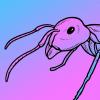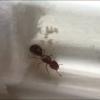So here's something to ponder about.
I was outside and I caught a Myrmica queen. So no not weird but It had no wing marks and it was aggressive to the workers of the large "main" colony of my backyard where it was near. It was also somewhat smaller than an average alate being 5mm so I believe it is a microgyne. I did some research and there are a few studies concluding that microgynes are actually social parasites that target old mature colonies to basically exchanging quality for quantity meaning that they are more numerous than macrogynes but less efficient. So I would like to know if you ever encountered a microgyne in your captive colony and if so was it there originally or they developed later. I wonder if the microgyne might have been trying to infiltrate the colony or if they develop from the colony. Note that I broke open the colony a few times before, found larvae and pupae but never encountered a queen. The alates released during nuptial flights last year (from my bad vague memory) were all macrogynes.














![[Discontinued] Karma's Ant Journals (Camponotus, Formica, Lasius, Manica, Myrmica) - last post by Karma](https://www.formiculture.com/public/style_images/shivana/profile/default_large.png)



